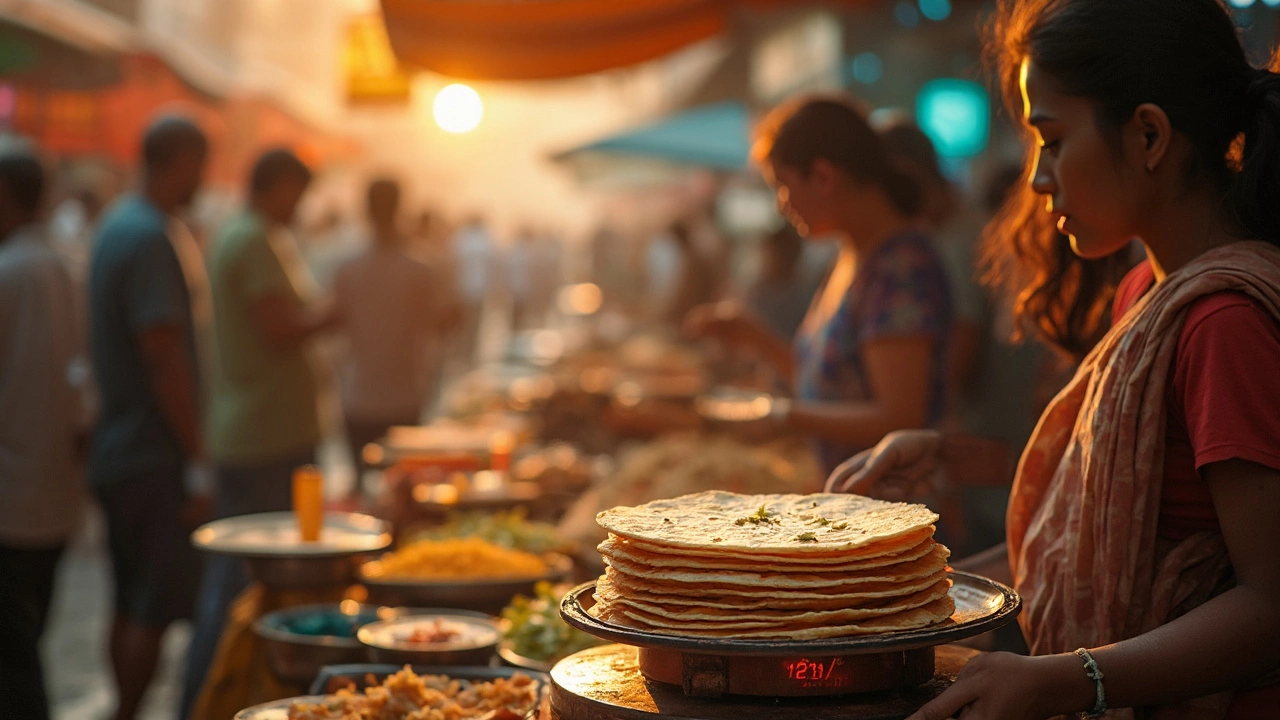Track Your Roti Consumption with This Calorie Calculator
 Feb, 28 2025
Feb, 28 2025
If you’ve ever wondered how many chapatis you can eat in a day without throwing your diet out of balance, you’re not alone. In a culture where roti is a staple, it’s important to know its impact on your calorie intake and overall health. That's where a calorie calculator comes in handy, giving you a clear picture of your daily consumption. Understanding how your Body Mass Index (BMI) ties into this can also help you make more informed decisions.
Let's kick things off with the basics: how many calories are in one roti? It's typically about 70-80 calories. Now, consider your BMI—a measure that helps you understand whether you're underweight, overweight, or just right. This number can guide your chapati intake. So how do you effectively use a calorie calculator? It’s straightforward. Input your BMI, daily activity level, and dietary goals to see how many chapatis fit into your daily caloric budget.
- Understanding Calories in One Roti
- How BMI Influences Roti Consumption
- Using a Calorie Calculator Effectively
- Legal Insights on Dietary Guidelines in India
- Local Tips for Managing Chapati Intake
Understanding Calories in One Roti
In Indian households, roti or chapati is a staple food. But, do you know exactly how many calories you're consuming with each one? On average, a plain roti made from whole wheat contains about 70-80 calories, varying slightly due to size and thickness. Given its significance in our diet, getting to grips with these numbers is key to managing your intake and balancing your total caloric consumption each day.
Why Calories Matter
For those keeping an eye on weight loss or maintenance, understanding calories is crucial. Calories are units of energy and indicate how much energy food will provide. The key is to balance calories consumed with calories burnt. If 'how many Chapatis Should You Eat in a Day?' has crossed your mind, it often boils down to meeting your caloric needs without excess. Understanding your Body Mass Index (BMI) can help tailor your diet plans.
Step-by-Step Guide to Monitor Roti Consumption
- Note the number of rotis you usually consume per meal.
- Calculate the total calories by multiplying the number of rotis with the calories per roti.
- Compare your total calorie consumption against your daily requirements, guided by your BMI.
- Use a calorie calculator to help balance your daily intake with your macro-nutrient needs.
Local Variations and Tips
Roti recipes can vary greatly across different parts of India, potentially altering the calorie count. For instance, adding ghee or making stuffed parathas increases the calories. In a diverse city like Mumbai, the local food scene encourages variety. Try balancing one plain roti with a variety of vegetables or lean proteins for a more nutritious meal.
Legal Guidelines for Nutritional Information
In India, food laws require packaged roti products to display clear nutritional facts. If you're buying packaged products, keep an eye out for these labels to manage your diet better. Meanwhile, it's worth noting that homemade rotis offer better control over ingredients and portion size.
Tracking your calories doesn't have to be a chore. With a bit of awareness and the right tools, you can enjoy your meals while staying healthy!
How BMI Influences Roti Consumption
Understanding Body Mass Index (BMI) is crucial when figuring out your daily diet, especially in terms of roti consumption. BMI indicates body fat based on height and weight, helping you decide how many chapatis you should include in your meals. Here's a simplified guideline:
- Calculate Your BMI: Use a BMI calculator online by entering your height and weight. The formula is your weight in kilograms divided by your height in meters squared (kg/m²).
- Interpret Your BMI Result: Based on the score, you'll fall in certain categories: underweight (below 18.5), normal weight (18.5–24.9), overweight (25–29.9), or obese (30 and above).
- Adjust Roti Intake: For those in the normal range, sticking to around 3-4 chapatis daily can maintain a balanced diet. If you're overweight, it might be wise to reduce this number and incorporate more vegetables and proteins.
It's not just about numbers; personalized advice from a nutritionist in Mumbai can also give insights based on local dietary habits and ingredients. They may emphasize incorporating alternative grains like jowar or bajra as per seasonal availability.
Be aware of dietary regulations and initiatives in India focusing on public health nutrition. If you're trying to manage your weight, it's essential to understand food labeling laws, ensuring you know what goes into packaged chapatis you might buy.
A quick legal tip: Familiarize yourself with the Food Safety and Standards Authority of India's guidelines. They've got regulations on labeling and food safety that are worth a glance if you're mindful of what you eat.

Using a Calorie Calculator Effectively
So, you want to keep an eye on your chapati intake in a fun yet practical way? A calorie calculator can be your best friend here. It's as easy as entering a few numbers and letting the calculator crunch them for you. Here's how to get started:
Step-by-Step Guide
- Know Your Calories: First, identify the calories in one roti. On average, a single roti has around 70-80 calories. This can vary slightly based on size and preparation.
- Input Your BMI: Make sure you know your current Body Mass Index (BMI). This gives context to the results and helps personalize recommendations. Not sure? A quick online tool can measure it precisely.
- Calculate Your Needs: Enter your daily caloric needs into the calculator. Remember, it trends differently based on age, sex, and activity level. The calculator should adjust per your inputs.
- Adjust as Per Goals: Be honest with your dietary goals. Do you want to maintain, gain, or lose weight? The calculator will set the number of chapatis you can comfortably consume without overstepping.
Local Considerations
In Mumbai, local foods take precedence, and rightly so. The trick is balancing traditional meals with modern dietary insights. Hence, using a calorie calculator adapted to local foods can better align with dietary guidelines set locally.
Legal Aspects
Regulations about dietary information are important. Ensure the tool or calculator you use is recognized or recommended by local health authorities. Standards set by the Food Safety and Standards Authority of India (FSSAI) influence credibility.
Equipped with a calorie calculator, you can make informed lifestyle choices that respect tradition while embracing a healthy future. Remember, it’s not just about numbers but about understanding how those numbers fit into your everyday life in Mumbai.
Legal Insights on Dietary Guidelines in India
In India, dietary guidelines are shaped and enforced by institutions like the Indian Council of Medical Research (ICMR) and the Food Safety and Standards Authority of India (FSSAI). If you're wondering how many Chapatis Should You Eat in a Day, these organizations provide some valuable insights.
ICMR Guidelines
ICMR sets forth comprehensive dietary recommendations to ensure nutritional adequacy for different populations. Their guidelines emphasize balanced diets that include cereals, such as roti, which are a major source of energy. The recommended dietary intake of calories, which includes the Calories in One Roti, forms part of a holistic approach to health.
FSSAI's Role
The FSSAI plays a crucial role in ensuring food safety and quality in India. While they don't specifically dictate how many chapatis to eat, their regulations ensure that foods available in the market, including flours used to make roti, meet safety standards, affecting daily consumption indirectly.
Legal Standards in Mumbai
Being in a bustling metropolis like Mumbai, residents have to consider additional factors such as dining out and food delivery services. Mumbai adheres to the FSSAI's standards, ensuring that even restaurant-prepared rotis meet hygiene standards. Always check for FSSAI certifications when ordering food or buying packaged atta (flour).
How to Stay Compliant
- Keep track of your caloric intake using tools like a calorie calculator. This assists in ensuring your intake aligns with ICMR's guidelines.
- Look for FSSAI certifications when purchasing ingredients or dining out, ensuring safety and compliance.
- Use fresh and locally sourced ingredients to maintain the nutritional quality suggested by dietary experts here in India.
Understanding these legal insights not only helps manage your BMI but also ensures that every roti you consume is contributing positively to your health.

Local Tips for Managing Chapati Intake
Living in Mumbai, roti is a staple that finds its way into almost every meal. It’s easy to lose track of how much you're consuming, especially when you're at a family gathering or a festive feast. But managing your chapati intake doesn’t have to be a Herculean task. With some practical advice suited for our local lifestyle, you can enjoy your meals without worrying about overdoing it.
Serving Size Matters
First things first, keep an eye on your serving size. A standard roti usually weighs about 30 grams, translating to around 70-80 calories as we've discussed. Serving sizes can vary, so it's key to stick to the standard if you’re trying to calculate accurately. When at gatherings, try to notice the size of the chapati servings and adjust the number you eat accordingly.
Pair with Vegetables
Roti goes well with vegetables, which are low in calories and high in nutrients. Load up your plate with greens like spinach or bhindi (okra). This not only helps in keeping you full but also maintains a good calorie balance. Aim to fill half your plate with vegetables and the remainder with rotis and protein.
Stay Informed on Legal Dietary Guidelines
Did you know? According to India's Food Safety and Standards Authority (FSSAI), following the dietary guidelines can help maintain a balanced diet tailored to local eating habits. Familiarizing yourself with these guidelines can improve your decisions on chapati consumption while keeping it enjoyable and within legal recommendations.
Smart Use of a Calorie Calculator
Use a calorie calculator app on your phone to log the rotis you eat each day. Lots of apps have features to record calories alongside other nutrients, making it simple to adjust your meals accordingly. With technology, staying on track has never been easier.
Adopt the 10% Rule
Similar to western 'cheat meals,' the 10% rule suggests that about 10% of your diet can be flexible. If you know you’ll indulge in more rotis on a special occasion, balance them out earlier in the week by reducing your intake slightly. This way, you can enjoy without guilt.